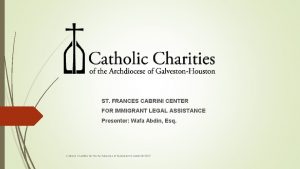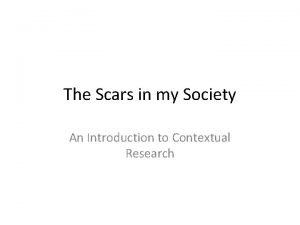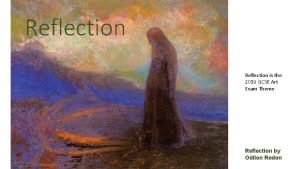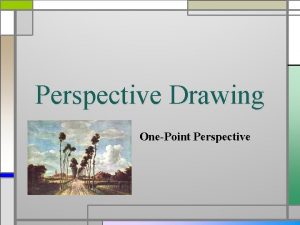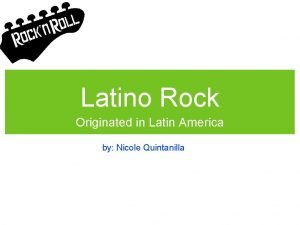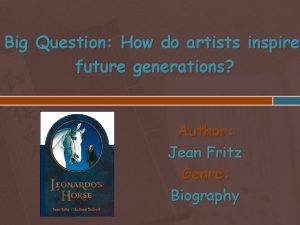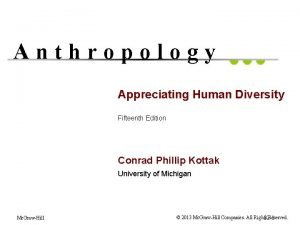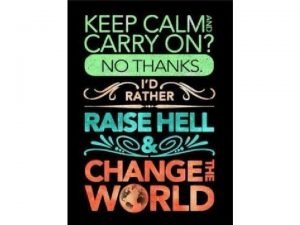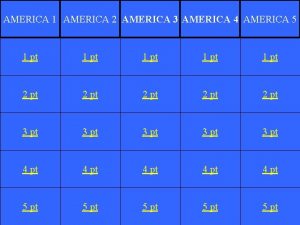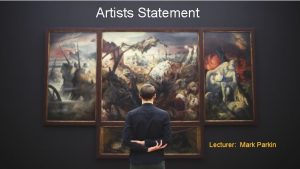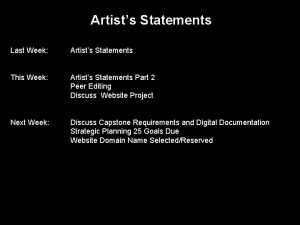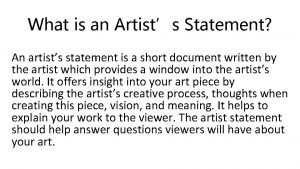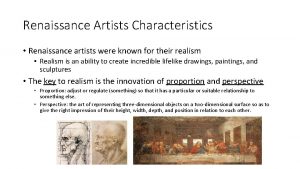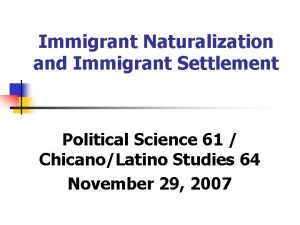Immigrant Artists and their Impact on America immigrant






















- Slides: 22

Immigrant Artists and their Impact on America im·mi·grant ˈiməɡrənt/ noun: immigrant; plural noun: immigrants a person who comes to live permanently in a foreign country. synonyms: newcomer, settler, migrant, emigrant; Morenonnative, foreigner, alien, outsider; expatriate; informalexpat "they will convene to discuss the civil liberties of immigrants” BIOLOGY an animal or plant living or growing in a region to which it has migrated.

Arshile Gorky - Painter Arshile Gorky was an ethnically Armenian painter, who had a seminal influence on Abstract Expressionism. He spent most his life as a national of the United States.

Louise Bourgeois Artist Louise Joséphine Bourgeois was a French. American artist. Best known for her largescale sculpture and installation art, Bourgeois was also a prolific painter and printmaker

Tony Ortega Mexican American Painter/Author My artwork reflects the Latino experience through individual slices of life of the community, family, and other sectors of urban and rural society. The collective is the primary focus in all my work. Individuals in my artwork are faceless because they are important only to the extent that they help define the group-the community interacting and participating in its many rituals, social settings, and group functions.

Carlos Villa - A Poet of Visual Metaphor For nearly fifty years Carlos Villa has explored the meaning of cultural diversity in his art and in doing so has expanded our awareness of what we consider as “multicultural. ” What began in his early career as an attempt to understand his own heritage--a complexity of Filipino traditions with its layered strains of Asian, African, Indian and Oceanic cultures, along with influences of a Western artistic tradition--became over time an exercise in creating his own visual anthropology to represent his personal background, and, in a broader sense, the dynamics of intercultural weaving. - Preston Fletcher

Chiura Obata (小圃 千浦 Obata Chiura? , November 18, 1885 - October 6, 1975) [1] was a well-known Japanese-American artist and popular art teacher. [2] A self-described "roughneck", Obata went to the United States in 1903, at age 17. After initially working as an illustrator and commercial decorator, he had a successful career as a painter, following a 1927 summer spent in the Sierra Nevada, and was a faculty member in the Art Department at the University of California, Berkeley, from 1932 to 1954, interrupted by World War II, [3] when he spent over a year in internment camps. After his retirement, he continued to paint and to lead group tours to Japan to see gardens and art.

Research and determine a Immigration story from your family or personal history and create an artwork that shows either the Narrative or the Feeling from that travel, transition, change, ……

Name: ________________ Univ: ______ Date: _____ Research and determine a Immigration story from your family or personal history and create an artwork that shows either the Narrative or the Feeling from that travel, transition, change, Experience, etc. Name of Immigrant: __________ Where did they travel from: ___________________ Describe whatever you can about the journey that took them from their original place to their current or final place: _____________________________________

Irish Gaelic Lettering Design from ancient times Gaelic Designs being used within Skyrim, the video game

After travelling to Japan Rauschenberg made his process-based collage and assemblage works by incorporating common materials in a random fashion. His mixed media assemblage entitled “Gold Standard” (1964), which incorporated a Japanese folding- screen and objects found from streets in Tokyo, is an example of West embracing the East.

Japanese Drawing Kappa water imp 1836

Greek Immigrants and Architecture being incorporated into America

This Pendleton travel bag sells for $180 at Urban Outfitters, a clothing retailer that has recently caused controversy with its own “Navajo” line, since renamed. This nine-element robe, named after the esteemed Chief Joseph, was first introduced as an Indian trade blanket by Pendleton in the 1920 s. Via “Language of the Robe. ”

Ester Hernández is a California painter and graphic artist of mixed Mexican and Yaqui heritage. In La Ofrenda (image on right) she recontextualizes the Virgin of Guadalupe from the traditional religious image of the Mexicans, Native Americans, and Mexican Americans into a contemporary Latino cultural icon. Representing the Virgin as a symbol of feminine strength, she depicts her in the form of a tattoo, forever emblazoned as a source of identity and adoration on a woman's back. Just as a devout visitor to a church might make an offering to an image of a saint, so the unidentified hand makes an offering of a rose to this Lady of Guadalupe. The contemporary hairstyle, earring dangling from a pierced ear, and slickness of the print surface are contemporary references. In keeping with Mexican American tradition, however, Hernández portrays the Virgin of Guadalupe as neither strictly Spanish nor Native American, but as a tawny-skinned Mestiza queen for the Americas.

Sun Mad 1982 Ester Hernández Media: serigraph on paper Size: sheet: 22 x 17 in. (55. 9 x 43. 2 cm)

Sueño (Dream: Eve before Adam) Alfredo Arreguín Sueño (Dream: Eve before Adam) 1992 Alfredo Arreguín Media: oil on canvas Size: overall: 72 1/4 x 144 1/4 in. (183. 5 x 366. 4 cm. ) Alfredo Arreguín is a Mexican American whose paintings contain densely patterned surfaces with precise details rendered in rich, jewel-like colors. The sources for his paintings are as complex as the works themselves, and often include references from Central America, Europe, and the Near East. His experiences in the Mexican rain forest of Guerrero and in the temperate rain forest near his Seattle home have inspired many lush and beautiful tributes to rain-forest ecosystems. In his triptych

Mis Hermanos 1976 Jesse Treviño Media: acrylic on canvas Size: 48 x 70 in. (121. 9 x 177. 8 cm. ) Smithsonian American Art Museum Gift of Lionel Sosa, Ernest Bromley, Adolfo Aguilar of Sosa, Bromley, Aguilar and Associates 1994. 74 Mis Hermanos Jesse Treviño The Chicano artist Jesse Treviño came from Monterrey, Mexico, to the United States as a child with his family. Later, while a student at the Art Students League in New York City, he was drafted into the U. S. Armed Forces and sent to Vietnam. There he was seriously injured, losing his right arm when his platoon was hit by sniper fire. He spent two years in hospitals recovering from his injuries and learning to paint with his left hand. He enrolled in a drawing course at San Antonio College and continued to learn to paint and draw with his left hand. Eventually, he earned his Bachelor of Arts degree from Our Lady of the Lake University and a Master of Fine Arts in painting from the University of Texas at San Antonio. Subjects for the artist’s striking paintings usually include contemporary street scenes, buildings, and people from the Mexican American barrios (neighborhoods) of San Antonio, as in Mis Hermanos. In essence, his paintings, rendered in a style described as both realistic and photorealistic, are snapshots that capture the experience of community life for Mexican Americans today. He describes his work: The Chicano community is an integral part of the family structure and a social organization providing a point of reference for my work. The images are a natural outgrowth of interrelating my environment with the family structure. These very personal portraits are also visual representations of the diverse aspects of the Chicano culture.

Artwork from Japanese Americans who where placed in internment camps during WW 2

Artist: Arshile Gorky (1904 -48), one of the greatest American painters, was so uncertain about how to make sense of his Armenian origins that he adopted a Russian name, telling people he was the nephew of the writer Maxim Gorky - implausibly, since this was a pen name. Arshile Gorky's real name was Vostanig Adoian. Born in Khorkom, on the shores of Lake Van in eastern Turkey, he had a childhood dominated by nature, folklore and religion, marred only by the departure of his father for America. In 1915 Turkey decided to get rid of its Armenian minority. Throughout eastern Turkey, Armenian men were taken out of their villages and murdered, women and children driven on forced marches causing mass starvation. An estimated million people died. Gorky's family fled to Yerevan, now capital of Armenia. After his mother died of starvation in 1918, Gorky made it to Ellis Island. With a habit of making up stories about his meetings with famous artists, he became an art teacher and avant-garde painter in New York. He was connected with artists who would, with him, become known as the Abstract Expressionists Arshile Gorky's The Artist and His Mother (ca. 1926– 1936), Whitney Museum of American Art, New York City.

Jean-Michel Basquiat , paint, oil stick on board, Untitled (History of the Black People) 1983 According to Andrea Frohne, Basquiat's 1983 painting Untitled (History of the Black People) "reclaims Egyptians as African and subverts the concept of ancient Egypt as the cradle of Western Civilization". At the center of the painting, Basquiat depicts an Egyptian boat being guided down the Nile River by Osiris, the Egyptian god of the earth and vegetation. On the right panel of the painting appear the words “Esclave, Slave, Esclave”. Two letters of the word "Nile" are crossed out and Frohne suggests that, "The letters that are wiped out and scribbled over perhaps reflect the acts of historians who have conveniently forgotten that Egyptians were black and blacks were enslaved. " On the left panel of the painting Basquiat has illustrated two Nubian-style masks. The Nubians historically were darker in skin color, and were considered to be slaves by the Egyptian people. Throughout the rest of the painting, images of the Atlantic slave trade are juxtaposed with images of the Egyptian slave trade centuries before. The sickle in the center panel is a direct reference to the slave trade in the United States, and slave labor under the plantation system. The word "salt" that appears on the right panel of the work refers to the Atlantic Slave Trade, as salt was another important commodity traded at that time.

In the Spaces recreate in color the artwork and answer the questions in complete sentences. Name: _________________ 1. What culture do you think the artist was originally from? _________________________________________________ 2. What influence do you think the artist’s original culture had on the creation of their artwork? _________________________________________________ 4. What does the artwork say about American Culture? _________________________________________________

In the Spaces recreate in color the artwork and answer the questions in complete sentences. Name: _________________ 1. What culture do you think the artist was originally from? _________________________________________________ 2. What influence do you think the artist’s original culture had on the creation of their artwork? _________________________________________________ 4. What does the artwork say about American Culture? _________________________________________________ On a Blank Sheet of Paper create your own full page full color design – showing an tale of immigration from your family’s history
 Immigrant power and control wheel
Immigrant power and control wheel Definiton of dignity
Definiton of dignity Peter skrzynecki feliks skrzynecki
Peter skrzynecki feliks skrzynecki Emigrant v immigrant
Emigrant v immigrant Lukioil
Lukioil Catholic charities cabrini center
Catholic charities cabrini center Rap of the map of the us
Rap of the map of the us America vs africa
America vs africa Repetition in let america be america again
Repetition in let america be america again Why is latin america called latin america
Why is latin america called latin america Eu amo a américa e a américa me ama
Eu amo a américa e a américa me ama Stereo hearts metaphor
Stereo hearts metaphor Scars in society artists
Scars in society artists Shaped canvases stella
Shaped canvases stella Reflections art gcse
Reflections art gcse Ancient egypt
Ancient egypt Interesting facts about ritchie valens
Interesting facts about ritchie valens Food collage art
Food collage art Why did muslims honor calligraphers above all other artists
Why did muslims honor calligraphers above all other artists Inspire future generations
Inspire future generations Famous artist statements
Famous artist statements In nonindustrial societies artists
In nonindustrial societies artists Famous tessellation artists
Famous tessellation artists





